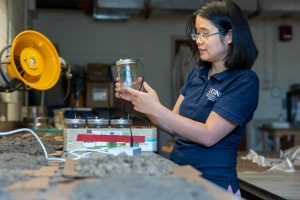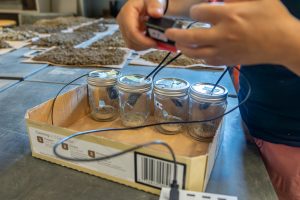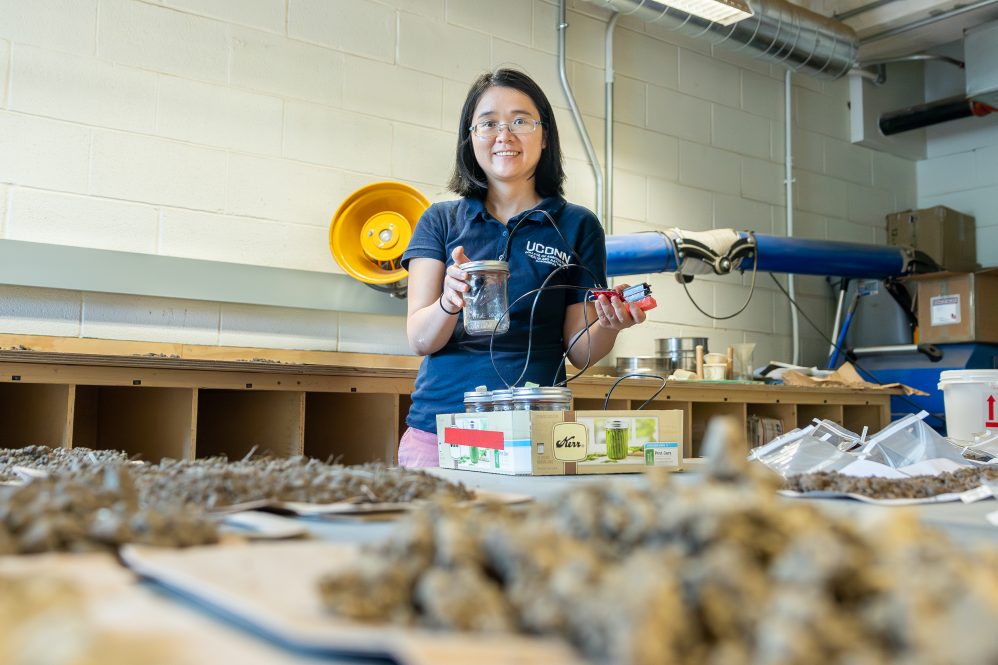Saying soil is important is an understatement. From serving as the medium where most of our food is grown, to sequestering carbon and reducing atmospheric CO2 concentrations, to being the home for enormous quantities of biodiversity – including antibiotic-producing bacteria — soil is key to life on Earth. However, current agriculture and land use practices degrade soil, and there are many unknowns about what factors make a healthy, resilient soil, mainly due to limited methods for assessment. Researchers at UConn are working to fix this.
“What’s measured can be managed,” says Assistant Research Professor in the College of Agriculture, Health and Natural Resources Huijie Gan. Gan and her co-authors are working on a cost-effective way to efficiently assess soil health at scale. Their findings are published in Soil Biology and Biochemistry.
“If you don’t know quantitatively what is missing, it is difficult to say how are you going to change anything,” says Gan, whose academic home is the Department of Plant Science and Landscape Architecture.

Gan explains this project grew out of the larger project by the USDA’s Natural Resource Conservation Service (NRCS), to find university collaborators to help quantify different aspects of soil functions and to see how soils function under different management practices. The goal of this project is to find a way to easily measure if certain soil improvements or conservation practices are successful or not, and why. This is increasingly important, especially for the development of climate-resilient agriculture practices that can help ensure food production in the face of climate change.
“We want to quantify a soil’s ability to support food production, but also other important ecosystem functions like regulating water infiltration and storage, reducing greenhouse gas emissions, and ability to store carbon,” says Gan. “Soils contain a lot of organic matter. Microbes are consistently breaking down complex forms of organic matter into simpler biologically active forms, releasing mineral nutrients for plant uptake and some CO2 in the process. We want enough of this kind of active carbon in the soil to support microbial activity and ecosystem functions, but we also want more stable soil carbon that is not easily released to the atmosphere.”
Gan explains that soil organic matter also functions like a sponge that absorbs water and affects how water moves through the soil. The resulting water dynamics affect the microbial decomposition of the organic matter, and these many soil processes are often intertwined which is why the concept of soil health emphasizes the need to look at soil with a holistic view.
However, soil health assessment is not easy, Gan explains. There is a debate in the soil science community regarding how soil health assessment should be done. A common approach is to quantify a select set of soil physical, chemical, and biological properties that are indicative of important soil functions and then assign soil health scores based on the range of measurement results from soils in the same region.
One widely used soil health indicator is called CO2 burst or short-term carbon mineralization, which is in the minimal data set recommended by USDA-NRCS and the Soil Health Institute. The standard protocol requires air drying the soil and then adding a predetermined amount of water. The water kickstarts microbial activity, which releases a burst of CO2. The amount of CO2 released during the incubation period is indicative of many things, such as total microbial biomass, the active organic matter pool, and plant nutrient availability.
“There are a few specialized commercial or governmental soil testing laboratories that will do this kind of soil health assessment,” says Gan. Most use the conventional alkali trap method, which uses small containers with an alkali solution to absorb CO2 from microbial respiration or rely on gas analyzers to measure changes in CO2 concentrations inside incubation jars over time.

With an interest in simplifying the process, Gan had concerns about how to scale up the measurements. While troubleshooting, she says a colleague suggested simple CO2 monitors frequently used in greenhouses or other enclosed spaces. Having relied on standard protocols for measuring CO2 in the laboratory using chemicals, calculations, and precision equipment, Gan had never considered another method.
“I didn’t know because we have a fixed protocol, and you just stick with that. I reviewed information on the sensors, and I thought, ‘Wow! These are promising.’”
Gan and co-authors secured funding to buy the electronics and sensors. With help from Ken Premo at UConn’s electronics shop in the School of Engineering’s Technical Services, they began to build the platform. The unit is comprised of a CO2 sensor, a display screen, a real-time clock, and a data logger, allowing the continuous collection of CO2 concentration data. Gan says recently with some additional coding help from computer science student Mason Ritchotte ’24 (ENG) they can now use a single microcontroller for multiple sensors to measure multiple samples at once.
“Suddenly, this process is a lot easier because we don’t need to do any chemistry or deal with hazardous wastes, and we can scale up to create a relatively high throughput platform to measure many samples at one time. You can have a lot of soil coming in, add water, close it, and then all the data are generated. The next step is to directly connect the sensor to the computer so it can generate graphs.”
In addition to measuring CO2 release from microbial respiration, Gan also incorporated a load cell into the sensor platform, enabling the simultaneous measurement of soil’s ability to retain water under simulated drought conditions. Many soils in Connecticut are developed on coarse-textured materials left behind from the last glaciation and are usually well-drained but prone to drought due to their inherently low ability to hold onto water. Increasing the content of soil organic matter, which acts like a sponge to absorb water, can increase soil’s resilience to drought. Gan and her graduate student Monique Michaud ’23 (CAHNR) are currently working on another NRCS-funded project to provide more accurate data on the hydraulic properties of Connecticut soils based on field measurements.
Gan and her colleagues tested the sensor platform by sampling soils from across Connecticut. Different soils have very different health profiles, explains Gan, and to capture the full spectrum, they sampled soil from many different management scenarios, including forests, hayfields, corn fields under both no-till and conventional practices, and lawns. Gan says they found that across these different conditions, the more disturbed soils – those experiencing higher levels of tilling or cultivation – had lower CO2 burst compared to soils that have not been tilled or plowed for many years. The soils that were more disturbed also retain less water than the less disturbed soils.
“Namely, the least-disturbed areas have more microbial respiration and hold more water under drying conditions. But when you look at the total amount of carbon and calculate the fractions released from total carbon, it is lower. They have more total carbon, but the fraction released is lower, meaning that a higher proportion of their carbon is more stable, which is good for long-term ecosystem functions. A healthy soil would have a large carbon pool and flux, and the carbon flux will support an active community of soil life,” says Gan.
These results are consistent with those using traditional lab methods, meaning this new platform is reliable. With this new device in mind, Gan has proposed to establish a semi-high throughput platform here at UConn, so anyone in the region can assess their soil’s health associated with soil carbon at a low cost. Then, a database can be established so we will know the status of the region’s soil health and start to build a better understanding of how different farming practices affect different aspects of soil health.
“With that baseline knowledge, we can develop the best way to implement measures for improvement,” says Gan. “We want to look at how well the soil can support other functions and evaluate the implications of different soil interventions.”
Gan also has collaborations with researchers in UConn’s Department of Engineering to incorporate nitrogen sensors into the configuration to gather even more data. Knowing the flux of nitrogen can help determine measures to help better manage nitrogen fertilizer applications to reduce emissions of nitrous oxide, a greenhouse gas around 300 times more potent than CO2. In the USA, almost three-quarters of the nitrous oxide emission is from agricultural soil management.
“We are building an integrative understanding of different soil functions and coming up with a way to scale up the process to generate a lot of data for research and practical management decisions.”
Decisions on how to manage our soils have implications on climate change because as Gan holds up a two-by-two-inch soil core sample, she explains that five of these samples total just around 500 grams (1.1 lbs) of soil that has about 2% soil carbon content. If the same quantity of soil were mismanaged and the carbon content dropped to 1%, which is common in frequently tilled soil, the amount of CO2 released would double the CO2 concentration in her entire office.
“Indeed, soil cultivation since the dawn of agriculture has released over 100 billion tons of carbon from the soil to the atmosphere,” says Gan. “The expansion of agricultural land use and aggressive tillage enabled by large machinery in modern farming has exacerbated the trend of C loss from soil.”
Fortunately, conservation practices such as using cover crops and reduced tillage can help to restore some of the carbon in soil organic matter.
“However, we know that soil carbon sequestration has its limit,” says Gan. “Even if we put the 100 billion tons of carbon back into the soil and completely restore soil organic matter to the pre-anthropogenic level — a daunting task — it would offset only one decade of current CO2 emission from the fossil fuel industry. It is important to note that current CO2 emission from fossil fuels is around 37 billion tons of CO2. Still, we want to build soil organic matter in our agricultural soils as much as we can because soil organic matter is critically important in maintaining soil functions in nutrient cycling, water regulation, soil biodiversity for pest suppression, just to name a few. By developing cost-effective methods to quantify these functions, we are hoping to contribute to efforts that increase the awareness of soil health and the adoption of soil health-promoting practices. A phrase that is often said among agronomists is: ‘We owe our very existence to the few top inches of soil and the occasional rains.’ If these topsoils are gone, due to degradation or erosion, it is almost impossible to get them back. Is soil a renewable resource? The answer is entirely up to our actions.”
This project is funded by the USDA-NRCS cooperative grant (NR193A750023C018) and the START Proof-of-Concept Fund from the University of Connecticut.



